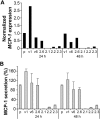Chronic inflammation: is it the driver or is it paving the road for malignant transformation?
- PMID: 26124920
- PMCID: PMC4482242
- DOI: 10.18632/genesandcancer.64
Chronic inflammation: is it the driver or is it paving the road for malignant transformation?
Abstract
Chronic inflammation in well-defined mouse models such as Giα2 knock out mouse has been shown to trigger formation and expansion of hypoxic niches and also leads to up regulation of NFĸB, offering cells which have adapted their genetic machinery to hypoxia a unique survival advantage. These adapted cells have been shown to acquire stem cell-like capabilities as shown by up regulation of stem cell markers. Such long lived cells become permanent residents in sub mucosa and acquire a malignant phenotype from long-term exposure to noxious environmental agents due to a barrier defect secondary to down regulation of barrier proteins such as Zo1 and Occludin. Indeed mitotic spindle disorientation in such mice has been proposed as another contributory factor to malignant transformation. Sterilization of bowel lumen of these mice through different techniques has prevented malignant transformation in the presence of chronic inflammation. These facts stand strongly against chronic inflammation as a true driver of carcinogenesis but clearly support its role in facilitating the emergence of the neoplastic clone.
Keywords: Chronic inflammation; Free energy; JAK2V617F; bioenergetics; driver mutation; electric field and cancer; metabolomics; p53 Rb.
Conflict of interest statement
The authors declare that they have no conflict of interest whatsoever.
Figures

Similar articles
-
Clonal heterogeneity as a driver of disease variability in the evolution of myeloproliferative neoplasms.Exp Hematol. 2014 Oct;42(10):841-51. doi: 10.1016/j.exphem.2014.07.268. Epub 2014 Sep 6. Exp Hematol. 2014. PMID: 25201757 Review.
-
Mouse models of intestinal inflammation and cancer.Arch Toxicol. 2016 Sep;90(9):2109-2130. doi: 10.1007/s00204-016-1747-2. Epub 2016 Jun 16. Arch Toxicol. 2016. Retraction in: Arch Toxicol. 2018 Nov;92(11):3441. doi: 10.1007/s00204-018-2312-y. PMID: 27311821 Retracted. Review.
-
Inflammation as a Driver of Clonal Evolution in Myeloproliferative Neoplasm.Mediators Inflamm. 2015;2015:606819. doi: 10.1155/2015/606819. Epub 2015 Oct 11. Mediators Inflamm. 2015. PMID: 26538830 Free PMC article. Review.
-
Benign-to-malignant B16 melanoma progression induced in two stages in vitro by exposure to hypoxia.J Natl Cancer Inst. 1994 Mar 2;86(5):361-7. doi: 10.1093/jnci/86.5.361. J Natl Cancer Inst. 1994. PMID: 8308928
-
MiR-144 Increases Intestinal Permeability in IBS-D Rats by Targeting OCLN and ZO1.Cell Physiol Biochem. 2017;44(6):2256-2268. doi: 10.1159/000486059. Epub 2017 Dec 14. Cell Physiol Biochem. 2017. PMID: 29258088
Cited by
-
When a negative (charge) is not a positive: sialylation and its role in cancer mechanics and progression.Front Oncol. 2024 Nov 19;14:1487306. doi: 10.3389/fonc.2024.1487306. eCollection 2024. Front Oncol. 2024. PMID: 39628991 Free PMC article. Review.
-
A Review of RRx-001: A Late-Stage Multi-Indication Inhibitor of NLRP3 Activation and Chronic Inflammation.Drugs. 2023 Apr;83(5):389-402. doi: 10.1007/s40265-023-01838-z. Epub 2023 Mar 15. Drugs. 2023. PMID: 36920652 Free PMC article. Review.
-
GOLM1 restricts colitis and colon tumorigenesis by ensuring Notch signaling equilibrium in intestinal homeostasis.Signal Transduct Target Ther. 2021 Apr 14;6(1):148. doi: 10.1038/s41392-021-00535-1. Signal Transduct Target Ther. 2021. PMID: 33850109 Free PMC article.
-
The role played by bacterial infections in the onset and metastasis of cancer.Curr Res Microb Sci. 2021 Oct 26;2:100078. doi: 10.1016/j.crmicr.2021.100078. eCollection 2021 Dec. Curr Res Microb Sci. 2021. PMID: 34841367 Free PMC article. Review.
-
Characterization of dysregulated glutamine metabolism in human glioma tissue with 1H NMR.Sci Rep. 2020 Nov 24;10(1):20435. doi: 10.1038/s41598-020-76982-7. Sci Rep. 2020. PMID: 33235296 Free PMC article.
References
-
- Afrasiabi K., M.-S. J. Free energy measurement distinguishes normal from cancer cell, offering a new perspective for curing cancer. OnLine Journal of Biological Sciences. 2013;12:11–125.
-
- Zhou Y.H., Wu X., Tan F., Shi Y.X., Glass T., LIu T.J., Wathen K., Hess K.R., Gumin J., Lang F. PAX6 suppresses growth of human glioblastoma cells. J Neuro-Oncology. 2005;71:223–229. - PubMed
-
- Warburg O. On the origin of cancer cells. Science (New York, N.Y.) (1956);123:309–314. - PubMed
-
- Kumar S., Donti T.R., Agnihotri N., Mehta K. Transglutaminase 2 reprogramming of glucose metabolism in mammary epithelial cells via activation of inflammatory signaling pathways. International journal of cancer. Journal international du cancer. 2014;134:2798–2807. - PubMed
LinkOut - more resources
Full Text Sources
Other Literature Sources
Research Materials
Miscellaneous

